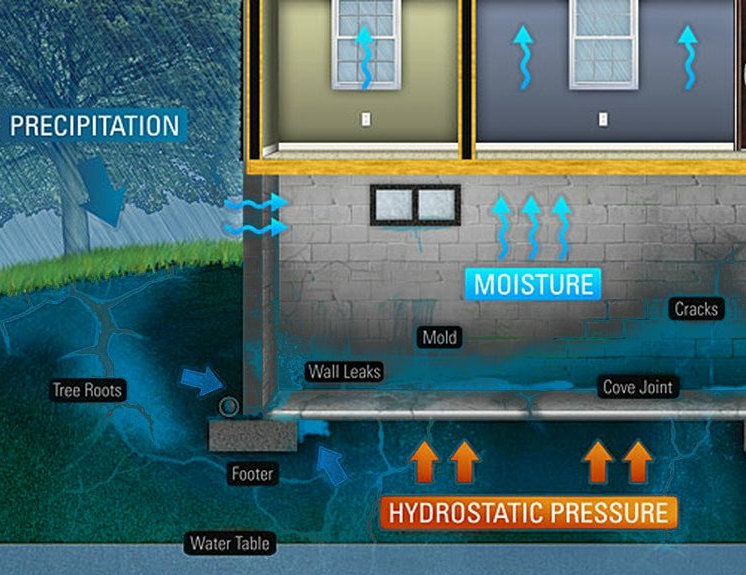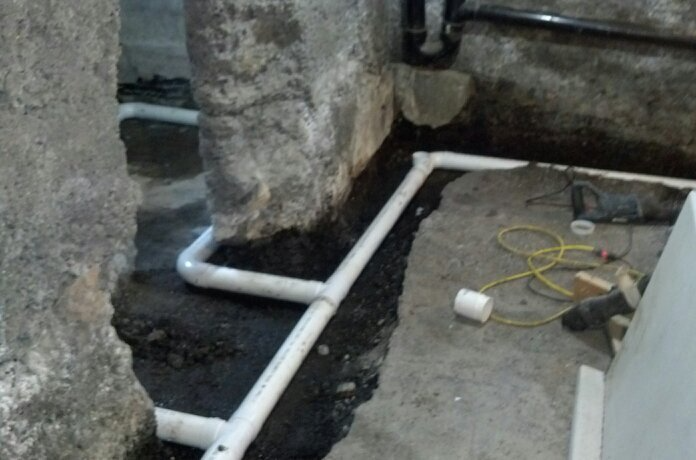Basement Hydrostatic Pressure Drainage Systems
Hydrostatic Pressure Drainage Systems
If water enters your basement through the floor, or between the wall and the floor, this is due to "Hydrostatic Pressure". Basement Hydrostatic Pressure leads the groundwater below the basement and pushes it through your basement floors as the water table rises. As the water table rises, the water infiltrates through the path of least resistance and/or gaps in your concrete, usually between the floor and wall and/or through floor cracks.
The solution is to divert water away from your basement floors via drainage systems and supplemental drains to direct the flow of water.
Our NOVA WATER-DRAIN SYSTEM is a superior system designed to alleviate hydrostatic pressure. It successfully prevents water from seeping into and through your basement walls. This system will forever prevent hydrostatic pressure; you will never see a drop of water again!
The NOVA WATER-DRAIN SYSTEM is usually installed from the interior, right inside your basement. This is typically cheaper than installing at the exterior of your home. However, either option can be done. Please see below the difference between the our INTERIOR WATER-DRAIN SYSTEM and EXTERIOR WATER-DRAIN SYSTEM:
Interior Waterproofing
Interior waterproofing makes sure that water that leaks into the basement is re-routed out and away from the home, while your basement remains dry. The INTERIOR WATER-DRAIN SYSTEM is made up of pipes and gravel installed under the foundation in order to collect excess groundwater. This excess water is usually directed to a sump pit which is installed flush below ground level. Then comes the duty of our NOVA-PUMP SYSTEM, which is a water pump that sits inside the sump pit and pumps water out of the basement and away from your home. The NOVA-PUMP automatically pumps out the water when it reaches a certain level in the sump pit. We also have optional battery back-up systems that will continue working in case of a power outage or during a severe storm.
The NOVA (INTERIOR) WATER-DRAIN SYSTEM comes with access ports in each corner, flush with the floor. These access ports allow access to the interior system for maintenance purposes. As well, the system also comes with DELTA-MS Air Gap Membrane installed on the walls and over the footing to catch any water that may infiltrate from future wall cracks, allowing it to drain into the NOVA INTERIOR WATER-DRAIN SYSTEM.New Paragraph
Pros:
- There is no disturbance to the exterior of the house.
- Halts floor and wall seepage usually without needing to completely remove all finished walls.
- More economical.
- Can be installed under any weather conditions.
- Interior systems are protected from natural elements such as soil conditions, tree roots, etc.
- Less time to complete versus the exterior method.
Cons:
- Bottom two feet of walls/insulation/studs etc are required to be removed.
- Shelves, cabinets, belongings, etc. may need to be moved away from exterior walls.
Basement work area is unusable during installation
Exterior waterproofing
Exterior waterproofing makes sure that water does not leak through the foundation walls at all, keeping your basement dry. The EXTERIOR WATER-DRAIN SYSTEM is made up of pipes installed around the perimeter of your foundation footing in order to collect excess groundwater. This excess water is drained away from the house using gravity method. While EXTERIOR WATER-DRAIN SYSTEM has the same goal as the interior system, there are some differences in how it is installed. Excavating the soil down to the footing of your foundation is required. The installation also includes washed stone gravel, pressure-washing of walls, two (2) coats of Rubber Coating on the walls, DELTA-MS Air Gap Membrane installed over the walls and footing, and 2" Polystyrene insulation.
Pros:
- There is little to no disruption to the basement interior.
- Exterior sealant is applied making sure your foundation is impervious to water
Cons:
- More labourous and costly than the interior system.
- Any landscaping, pavement or fixtures such as decks or steps close to the house have to be removed and replaced by the home owner.
- Exterior waterpoofing can take about 2 to 3 times longer than interior installation.
- Installation is weather permitting.
Regardless of the method you decide on, what’s important is that you are making the effort to keep your home warm and dry. If you have any questions about waterproofing methods, or if you are interested in interior and exterior waterproofing for your home, contact the experts at NOVA DRY BASEMENT SYSTEMS for more information and a free assessment!
Safeguard Your Basement: Waterproofing Solutions
Prevent basement leaks and damage with effective waterproofing solutions. From installing a drainage system to coating walls with paint-on waterproofing, these measures will keep your basement dry and protected from water damage and Basement Hydrostatic Pressure. Learn how to install a drainage system, prepare your walls, and apply waterproofing coatings and an Interior drain system to keep your basement safe and secure.
Putting up a Drainage System
Installing drainage tubing beneath the basement floor and connecting it to a sump basket and pump is the best long-term solution for persistent basement leaks. A system like this can be installed by hand, but it takes a lot of backbreaking labor to remove the concrete floor, bury the tubing, and patch the floor.
Basement wall waterproofing
Paint-on waterproofing coatings plug up any pores in masonry or concrete walls to keep water out. These coatings need to be applied to bare masonry or concrete walls in order to be effective. With a wire brush, start by eliminating any loose particles. Then use masonry cleaner to remove any white powdery "efflorescence."
Pay close attention to the safety and application directions. Spreading out the use of masonry waterproofing solutions is a common error. In order to produce a continuous waterproofing membrane, it is necessary to fill every pinhole. In order to completely fill each pinhole, brush the coating in all directions. After the first layer dries, apply a second.




